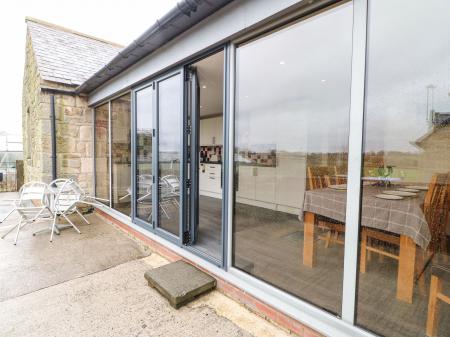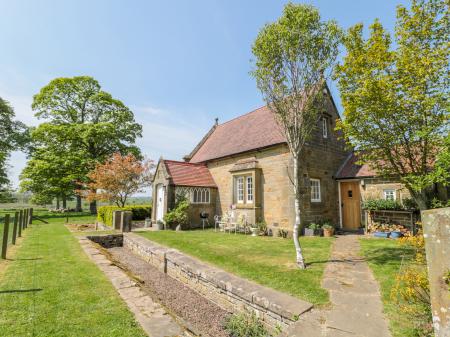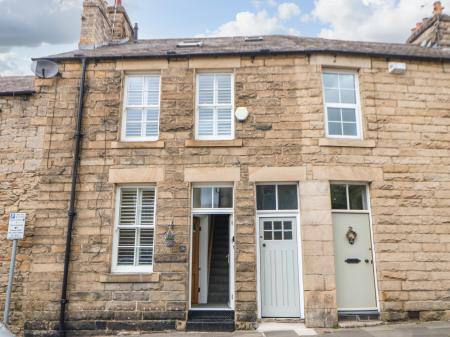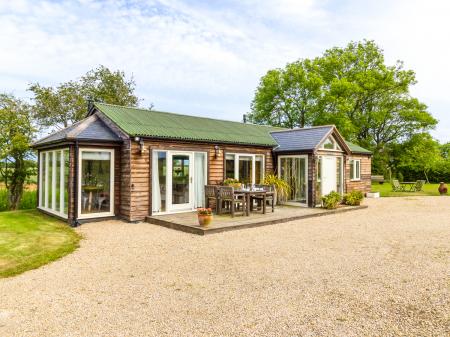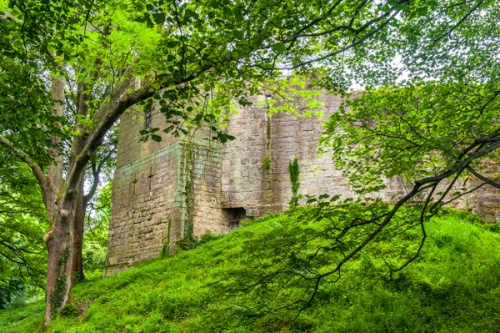
The castle was enlarged in 1300 with the addition of two guard towers. In 1398 the powerful Percy family, Earls (later Dukes) of Northumberland took over Prudhoe and they added a more sizable great hall.
Unlike many medieval fortresses, which were allowed to fall into disrepair when their defensive uses faded, Prudhoe was continuously occupied and was refurbished in the Victorian period to produce a comfortable Gothic Revival house, occupied by the 2nd Duke of Northumberland's land agent.
The castle is now in the hands of English Heritage, who have created displays explaining the long history of the castle, with plenty of hands-on exhibits to entertain visitors young and old.
History
Prudhoe was one of a string of Norman castles erected along the Tyne, beginning shortly after the Conquest, around 1095 AD. The first castle was a very simple timber structure, with a traditional Norman motte and bailey arrangement of a wooden palisade atop a high mound, linked to an enclosed area called a bailey. The castle was the administrative centre of a large tract of land known as the Barony of Prudhoe, granted by William the Conqueror to the Umfraville family.
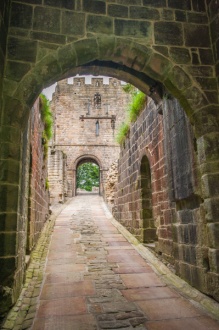
12th-c gatehouse
The Scots Attack
Then events took a curious twist, for in 1139 King Stephen granted the Earldom of Northumberland to the Scottish crown. Many northern nobles, including the Umfraville lords of Prudhoe, attended the Scottish court. Odinel d'Umfraville was actually brought up at the Scottish court, but when Henry II of England reclaimed the Earldom in 1151, Umfraville sided with his English overlord. King William the Lion of Scotland was enraged at Umfraville's turn of allegiance, and he attacked Prudhoe in 1173.
He was beaten off but returned again in 1174. Once again the Scots were rebuffed, and William was captured after giving up the siege. Interestingly, we know a lot about the first siege, which was witnessed by Jordan Fantosme, clerk to the Bishop of Winchester. Fantosme's account of the conflict gives a vivid portrayal of medieval siege warfare.
In the late 13th century Prudhoe housed Scottish prisoners awaiting ransom. Around the same time, the castle defences were strengthened, against the highly likely event of Scottish attack.
When the last male heir of the Umfraville family died in 1381 the 1st Earl of Northumberland, Henry Percy, married his widow Matilda, herself one of the largest landowners in the north. Thus the Percy family became the most powerful noble family in the north of England and took over the barony of Prudhoe.
The Percy's rebelled in 1405 and Henry IV granted the estates to his brother John, Duke of Lancaster. Prudhoe was later attacked and captured by the Yorkist leader Edward IV during the Wars of the Roses, but in an ironic twist, the Percy's regained the barony in 1470.
The castle passed largely unscathed through the Civil War, but by the late 17th century the Percy family moved their centre of administration to Alnwick Castle and left Prudhoe in the hands of the earl's officials. It was later rented out to local farmers and ceased to have any real military function.
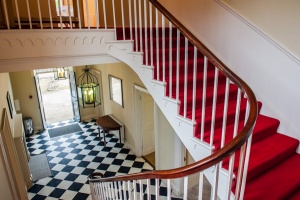
The House
Built between 1810-1818 for William Laws, land agent for the 2nd Duke of Northumberland. The large number of public reception rooms shows that this was meant to be a residence for a gentleman, active in society. Designed by Newcastle architect David Stephenson, the early 19th-century building incorporates medieval walls from the earlier keep.
These original features meld with Regency style, including Egyptian motifs, to create an unusual and refined house. One room of the house is given over to the English Heritage gift shop and ticket office, while chambers on the first-floor host an exhibition on Prudhoe's history, and an activity area for children.
The Gatehouse and Chapel
The only entrance to the castle is through a fortified gatehouse, built before 1150. Just down the sloping hill in front of the gatehouse is the ruin of an old mill. Though the ruined building we see now dates from the 18th century, there has been a mill on the site since the medieval period.
The mill was owned by the lord, and all villagers were required to pay the lord a fee to grind their grain here. On either side of the gatehouse passage are a pair of carved heads, acting as corbels. Over the gatehouse arch, reached by an outside stair, is a small chapel.
One striking feature of the chapel is a projecting, oriel window jutting out from the eastern end of the structure. This is thought to be one of the earliest oriel windows in any English castle, perhaps in any English building of any description.
The Keep
At the centre of the inner bailey, reached through the later 19th-century house, is the original late 12th century keep built by the Umfravilles. You can only access the ground floor of the keep; all else is a roofless shell, though it stands to an impressive height. The original Norman entrance was at first-floor level; look for the doorway later reused as a window in the 1330s. You can see the stairs built into the thickness of the wall that led up to a wall walk, and a pair of 14th-century windows.
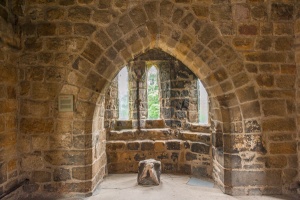
The Outer Bailey
Most of the public buildings were situated here, including the kitchens, bakehouse, brewhouse, and stables., as well as secondary lodging. You can see remains of two great halls, and a third - the original Norman hall - is hidden beneath the ground surface. In the 15th century, a new rectangular hall was built, but this was torn down in the 16th century when Prudhoe ceased to be so important to the Percy lords, and was replaced by a smaller hall. You can see the foundation walls of this smaller building within the outline of the earlier Percy hall.
There is a trail around the outside of the motte which gives you a very good look at the quite amazingly well-preserved outer walls of the castle, and you can enjoy the later terraced garden reached from the gatehouse walk. One unexpected pleasure is a prehistoric cup and ring marked stone on display in the outer bailey. This was found reused in the foundation of a medieval outbuilding.
Prudhoe Castle is located off the A695 (head uphill, away from the river) and there is a small parking area, free for visitors.
Summing Up
I really enjoyed the castle; it is more impressive than many, more famous medieval fortresses, and has an intriguing history. It is fascinating to see a castle that was not simply left to crumble into ruin but was adapted and used for different purposes throughout its history.
- Historic Highlights
- Late 12th-century keep
- 1150 gatehouse
- Gatehouse chapel with very early oriel window
- Gothic Revival house between the inner and outer baileys
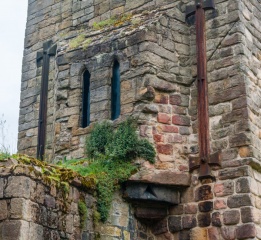
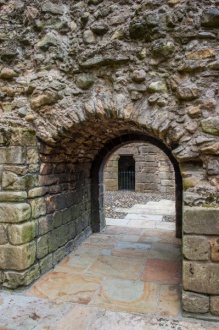
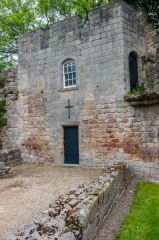
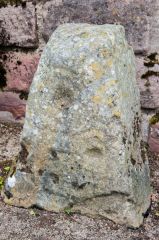
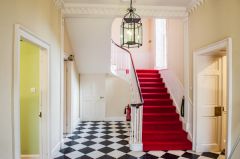
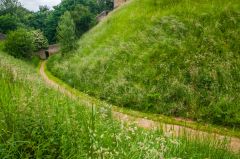
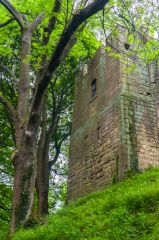
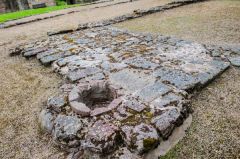
 We've 'tagged' this attraction information to help you find related historic attractions and learn more about major time periods mentioned.
We've 'tagged' this attraction information to help you find related historic attractions and learn more about major time periods mentioned.